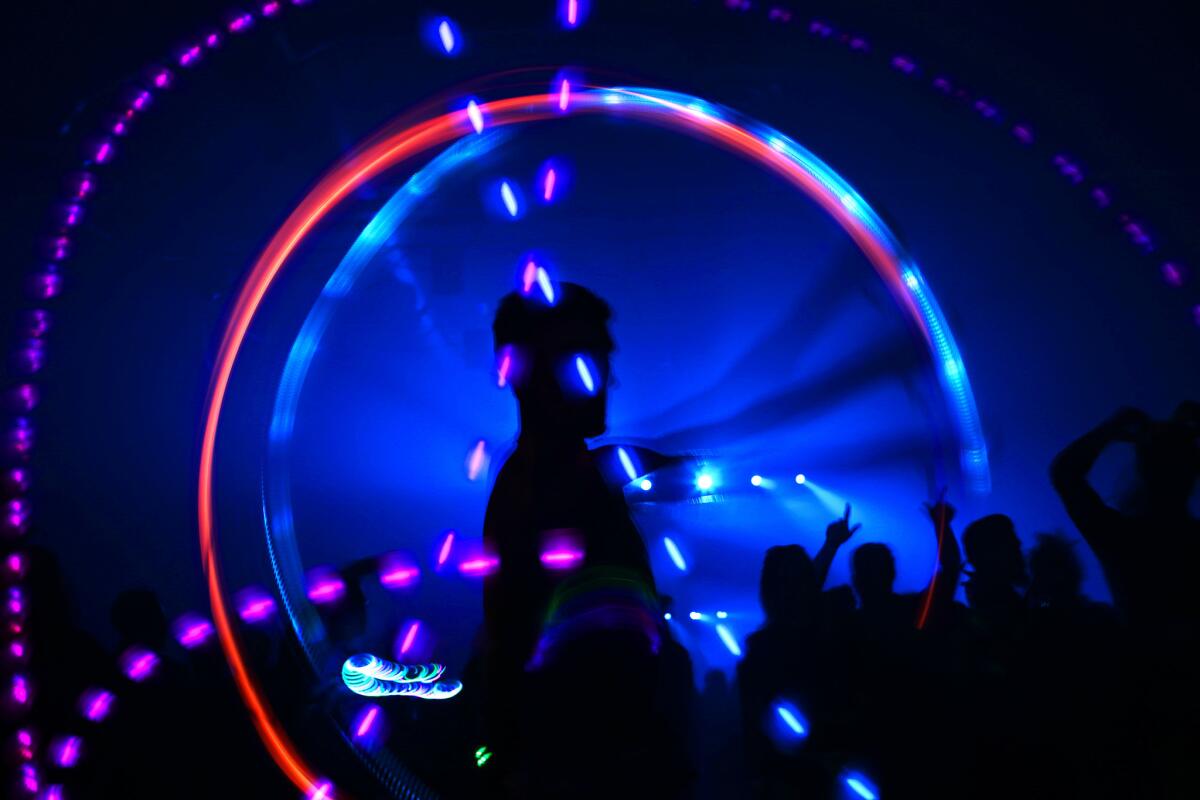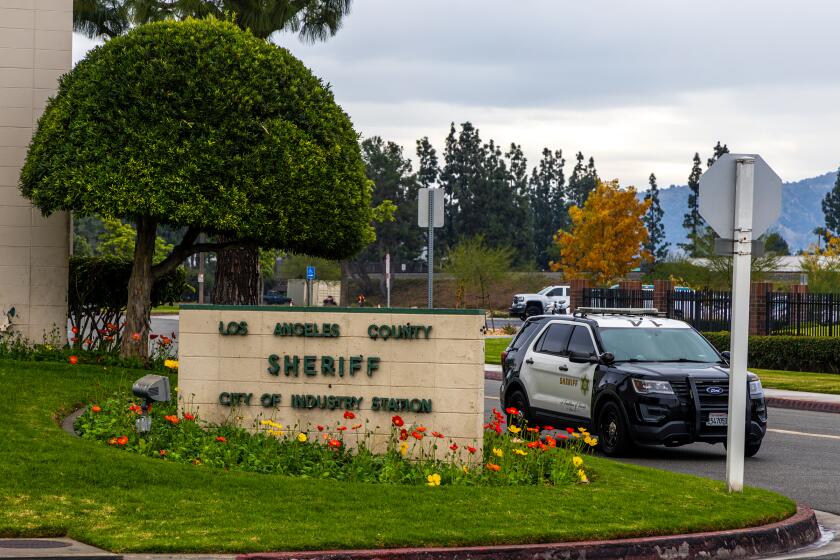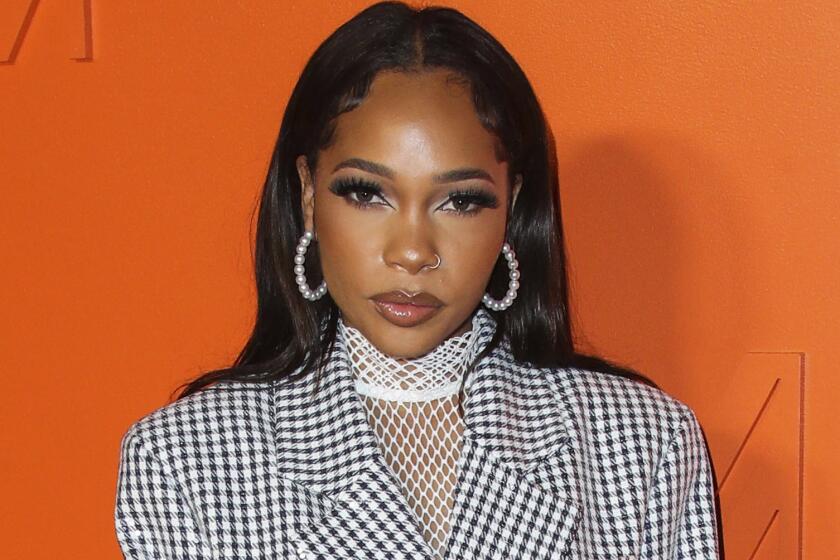Q&A: Laws aim to curb ‘heartbreaking’ loss of life at rave concerts, but effectiveness is limited

- Share via
The Labor Day weekend saw another major rave in Southern California. While no deaths were reported, more than 400 people were arrested at and five people were sent to hospitals from Nocturnal Wonderland, which drew more than 67,000 people at the San Manuel Amphitheater.
A string of drug-related deaths have prompted criticism from medical professionals and calls for stronger regulations. Some jurisdictions have cracked down with new laws. Rave operators said they’ve taken steps to make the events safer by adding security.
For the record:
10:41 p.m. Feb. 25, 2025A previous version of this story said that Insomniac’s chief executive, Pasquale Rotella, recently pleaded guilty to a conflict-of-interest charge in an alleged bribery and embezzlement scheme related to raves held at the Los Angeles Memorial Coliseum. Rotella pleaded no contest to that charge.
What laws have been passed?
In Los Angeles County, new laws regulating raves haven’t been tested — instead, the concerts have moved elsewhere, just beyond county jurisdiction.
California legislators and Los Angeles County supervisors have passed new laws that regulate events where there’s a strong chance that attendees could die. It applies on land owned, managed or otherwise governed by the state or county.
But that means the laws don’t apply on, say, property governed by the city of Los Angeles, or in San Bernardino County, which has increasingly become the home of massive raves in Southern California.
What is Sasha’s Law and how did it come about?
“It’s heartbreaking to me,” said Grace Rodriguez, whose 15-year-old daughter, Sasha, overdosed on Ecstasy while attending the Electric Daisy Carnival rave in 2010 at the Los Angeles Memorial Coliseum and later died.
Sasha’s death was the inspiration for the state bill known as Sasha’s Law. Rodriguez said she had hoped the state law would end the tragedies, but is now acutely aware of the limitations of the law’s reach.
“I just feel really bad for the parents,” Rodriguez said. “I know exactly what they’re going through. Exactly. And I feel so bad for them, because I know it could have been prevented.”
How many people have died after attending raves?
There have been at least 25 confirmed drug-related deaths nationwide since 2006 among people who went to raves organized by Los Angeles-area companies — Insomniac, Go Ventures, and Hard. Insomniac and Hard are now subsidiaries of the same company, Live Nation, which now dominate the electronic dance music festival scene in the region.
Of the 25 deaths, 12 died in Southern California.
How does the L.A. County law regulating raves work?
The L.A. County law, passed unanimously by the Board of Supervisors in March, regulates any mass event expecting more than 10,000 people a day that poses “a strong probability of loss of life to participants.”
It allows a panel of sheriff’s, fire and public health officials to limit attendance, ban alcohol sales and require promoters to provide free water, impose a minimum age requirement of 18 or 21, offer onsite medical care and increase security, such as ordering the use of drug-sniffing dogs.
“This sends a message to promoters that Los Angeles County will not tolerate any event that does not comply with the county’s requirements in order to protect the public,” said a spokesman for Supervisor Michael D. Antonovich.
The law affects land owned by the county and unincorporated areas directly governed by the Board of Supervisors.
Similar rules were put in place voluntarily for a Halloween-themed Hard Day of the Dead rave at the Los Angeles County fairgrounds last year. What was the reaction among the fan base?
One reviewer for consequenceofsound.net called some of the changes “the man’s best efforts to suck the life from the party.” And according to an L.A. Weekly review, the new measures took “what was once a great dance-music event and neutered it,” and led to “an all around-sense of buzzkill.”
How has the state law targeting raves worked?
There has been little publicity about the use of the state law in Los Angeles County. The Los Angeles Memorial Coliseum complex has not held a rave since the end of 2010.
The law has not meant an end to such events on state-managed property. Last August, after the Zoo-Tronic rave was held at the Fresno Fairgrounds, a 15-year-old girl who attended, Houa Lai Hue of Fresno, later died of Ecstasy poisoning, according to police and the coroner.
But that rave did not require the added level of scrutiny required under Sasha’s Law because only about 800 people attended, far under the 10,000 threshold spelled out in the law. This summer, the fairgrounds barred the promoter, Kailin Hwang, from returning after an event in June left the venue with damage and vandalism, a spokeswoman with the fairgrounds said.
Hwang then held another rave in July at the Crest Theater in Fresno, according to police. Ravegoer Debbie Yang, 18, of Merced later died from an Ecstasy overdose, according to the coroner.
What about L.A.?
Earlier this year, Los Angeles saw the return of the rave promoter Insomniac. Insomniac’s chief executive, Pasquale Rotella, recently pleaded no contest to a conflict-of-interest charge in an alleged bribery and embezzlement scheme related to raves held at the Coliseum. Prosecutors accused Rotella of hiring an “inside man” employed by the stadium, who continued advocating for raves following Sasha’s death.
Rotella’s company on May 7 held an event attracting about 20,000 people at the city-owned Los Angeles Convention Center, featuring the artist Kaskade.
Some attendees ended up in the emergency room. Patients suffered seizures, including one that was sent to intensive care, said Dr. Marc Futernick, medical director of emergency services at Dignity Health California Hospital Medical Center.
“These are all critical patients, and these events have life-long impacts to these patients. So even when we don’t have a couple of deaths, there are lots of ill people and medical consequences from these events,” Futernick said.
As president of the California chapter of the American College of Emergency Physicians, Futernick wrote a letter to city officials days before the event, urging them to take “all avenues to ban” it. There is “extreme strain and unnecessary risks incurred when there is a sudden influx of many critically ill patients into an already-stretched emergency care network,” Futernick wrote.
Jeff Gorell, Los Angeles’ deputy mayor for public safety, said in a statement that he had “deep concerns about reports of ill concertgoers,” and said he would work closely with the convention center’s operator, AEG, “to provide a safe experience for all who attend events.”
This summer, three young ravegoers died after attending the Hard Summer rave at the Auto Club Speedway in San Bernardino County. Is that county considering regulations?
The deaths have renewed a controversy over holding raves at a county-owned facility, the San Manuel Amphitheater in Devore.
In June, the San Bernardino County Board of Supervisors narrowly rejected an effort to end raves at the amphitheater. But one of the supervisors absent at that meeting, James Ramos, said in an interview last month that he would consider a moratorium on raves at the amphitheater.
Ramos expressed support to create a task force to study rave safety, much like what Los Angeles County supervisors did before passing their law.
“I would not be opposed to a moratorium on any future [rave] contracts” until a study is completed, Ramos said. “We’re going to look at everything.”
Supervisor Janice Rutherford continues to advocate for a ban on raves at the amphitheater, reminding her colleagues that two young people — Arrel Christopher Cochon, 22, a Los Angeles City College student. and John Hoang Dinh Vo, 22, a UC Irvine student — have lost their lives from drug overdoses after attending raves at the venue.
“The financial liability to the county, and the potential for more tragic deaths, are too great,” Rutherford wrote in a Facebook post.
Rutherford wrote that she supports allowing private venues to host whatever events they wish, including electronic dance music festivals, “so long as those events are done legally, i.e., obeying noise restrictions, proper security and medical care.”
What does Live Nation have to say about the controversy?
A spokeswoman for Live Nation declined to comment. On its website, Insomniac calls on its fans to be “safe, responsible and respectful to yourself and others,” and urges attendees to stay together with buddies, and said they provide medical stations and roaming medical teams to watch fans.
What do rave fans think about the controversy?
Rave fans defended the festivals, saying promoters should do whatever they can to make events safe, but emphasized that people need to take personal responsibility for decisions to take drugs.
“It’s all over the media that at these events, people pass away from taking Ecstasy. And if someone knows that full well, and still decides to proceed, of course it’s a sad situation if there’s a bad result. But that doesn’t seem to be a reason to punish the promoters when someone chooses to do that, when everyone is telling them not to,” said Greg Wasik, editor of EDMLife.com.
“Ninety-nine point nine percent of the people walk out of there happy, and have an amazing time,” Wasik said. “You could be taking away an experience that tens of thousands — and in the case of Electric Daisy, hundreds of thousands — enjoy.”
Twitter: @ronlin
ALSO
More than 400 arrested at Nocturnal Wonderland rave in San Bernardino County
Brock Turner registers as sex offender after he’s freed in Stanford sex assault case
Santa Barbara man is suspected of angling for discarded drugs
More to Read
Sign up for Essential California
The most important California stories and recommendations in your inbox every morning.
You may occasionally receive promotional content from the Los Angeles Times.











